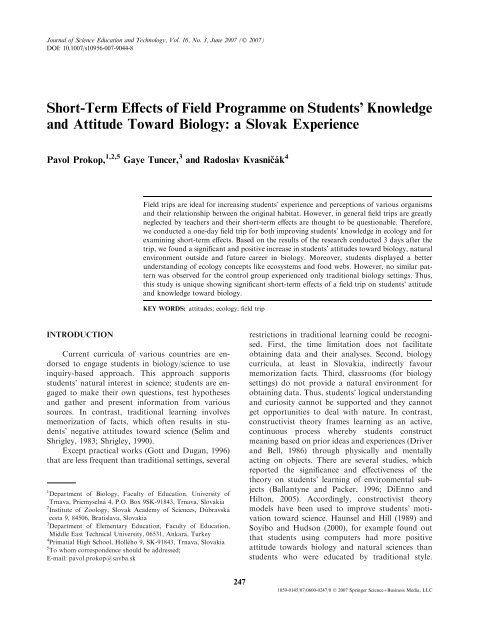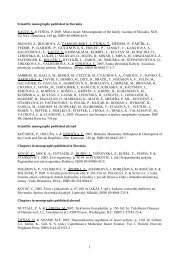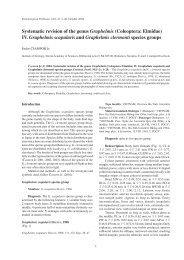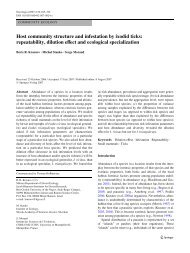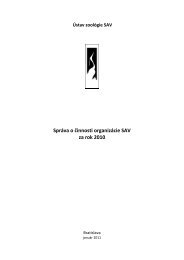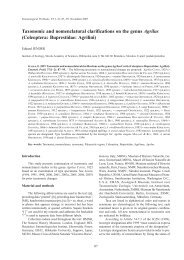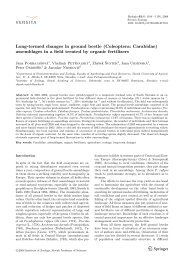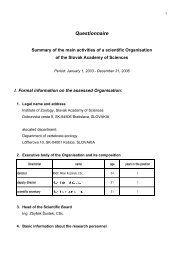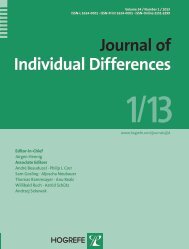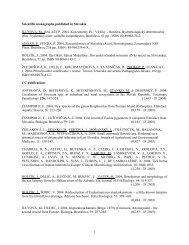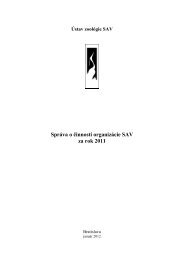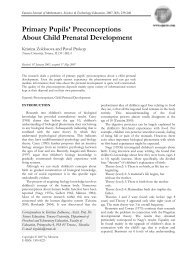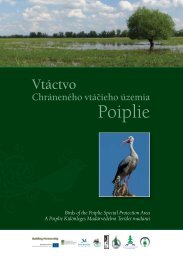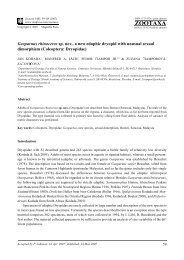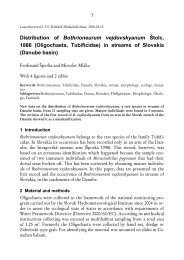Short-Term Effects of Field Programme on Students' Knowledge and ...
Short-Term Effects of Field Programme on Students' Knowledge and ...
Short-Term Effects of Field Programme on Students' Knowledge and ...
You also want an ePaper? Increase the reach of your titles
YUMPU automatically turns print PDFs into web optimized ePapers that Google loves.
Journal <str<strong>on</strong>g>of</str<strong>on</strong>g> Science Educati<strong>on</strong> <strong>and</strong> Technology, Vol. 16, No. 3, June 2007 (Ó 2007)DOI: 10.1007/s10956-007-9044-8<str<strong>on</strong>g>Short</str<strong>on</strong>g>-<str<strong>on</strong>g>Term</str<strong>on</strong>g> <str<strong>on</strong>g>Effects</str<strong>on</strong>g> <str<strong>on</strong>g>of</str<strong>on</strong>g> <str<strong>on</strong>g>Field</str<strong>on</strong>g> <str<strong>on</strong>g>Programme</str<strong>on</strong>g> <strong>on</strong> Students’ <strong>Knowledge</strong><strong>and</strong> Attitude Toward Biology: a Slovak ExperiencePavol Prokop, 1,2,5 Gaye Tuncer, 3 <strong>and</strong> Radoslav Kvasnicˇ a´k 4<str<strong>on</strong>g>Field</str<strong>on</strong>g> trips are ideal for increasing students’ experience <strong>and</strong> percepti<strong>on</strong>s <str<strong>on</strong>g>of</str<strong>on</strong>g> various organisms<strong>and</strong> their relati<strong>on</strong>ship between the original habitat. However, in general field trips are greatlyneglected by teachers <strong>and</strong> their short-term effects are thought to be questi<strong>on</strong>able. Therefore,we c<strong>on</strong>ducted a <strong>on</strong>e-day field trip for both improving students’ knowledge in ecology <strong>and</strong> forexamining short-term effects. Based <strong>on</strong> the results <str<strong>on</strong>g>of</str<strong>on</strong>g> the research c<strong>on</strong>ducted 3 days after thetrip, we found a significant <strong>and</strong> positive increase in students’ attitudes toward biology, naturalenvir<strong>on</strong>ment outside <strong>and</strong> future career in biology. Moreover, students displayed a betterunderst<strong>and</strong>ing <str<strong>on</strong>g>of</str<strong>on</strong>g> ecology c<strong>on</strong>cepts like ecosystems <strong>and</strong> food webs. However, no similar patternwas observed for the c<strong>on</strong>trol group experienced <strong>on</strong>ly traditi<strong>on</strong>al biology settings. Thus,this study is unique showing significant short-term effects <str<strong>on</strong>g>of</str<strong>on</strong>g> a field trip <strong>on</strong> students’ attitude<strong>and</strong> knowledge toward biology.KEY WORDS: attitudes; ecology; field tripINTRODUCTIONCurrent curricula <str<strong>on</strong>g>of</str<strong>on</strong>g> various countries are endorsedto engage students in biology/science to useinquiry-based approach. This approach supportsstudents’ natural interest in science; students are engagedto make their own questi<strong>on</strong>s, test hypotheses<strong>and</strong> gather <strong>and</strong> present informati<strong>on</strong> from varioussources. In c<strong>on</strong>trast, traditi<strong>on</strong>al learning involvesmemorizati<strong>on</strong> <str<strong>on</strong>g>of</str<strong>on</strong>g> facts, which <str<strong>on</strong>g>of</str<strong>on</strong>g>ten results in students’negative attitudes toward science (Selim <strong>and</strong>Shrigley, 1983; Shrigley, 1990).Except practical works (Gott <strong>and</strong> Dugan, 1996)that are less frequent than traditi<strong>on</strong>al settings, several1 Department <str<strong>on</strong>g>of</str<strong>on</strong>g> Biology, Faculty <str<strong>on</strong>g>of</str<strong>on</strong>g> Educati<strong>on</strong>, University <str<strong>on</strong>g>of</str<strong>on</strong>g>Trnava, Priemyselná 4, P.O. Box 9SK-91843, Trnava, Slovakia2 Institute <str<strong>on</strong>g>of</str<strong>on</strong>g> Zoology, Slovak Academy <str<strong>on</strong>g>of</str<strong>on</strong>g> Sciences, Du´bravskácesta 9, 84506, Bratislava, Slovakia3 Department <str<strong>on</strong>g>of</str<strong>on</strong>g> Elementary Educati<strong>on</strong>, Faculty <str<strong>on</strong>g>of</str<strong>on</strong>g> Educati<strong>on</strong>,Middle East Technical University, 06531, Ankara, Turkey4 Primatial High School, Hollého 9, SK-91843, Trnava, Slovakia5 To whom corresp<strong>on</strong>dence should be addressed;E-mail: pavol.prokop@savba.skrestricti<strong>on</strong>s in traditi<strong>on</strong>al learning could be recognised.First, the time limitati<strong>on</strong> does not facilitateobtaining data <strong>and</strong> their analyses. Sec<strong>on</strong>d, biologycurricula, at least in Slovakia, indirectly favourmemorizati<strong>on</strong> facts. Third, classrooms (for biologysettings) do not provide a natural envir<strong>on</strong>ment forobtaining data. Thus, students’ logical underst<strong>and</strong>ing<strong>and</strong> curiosity cannot be supported <strong>and</strong> they cannotget opportunities to deal with nature. In c<strong>on</strong>trast,c<strong>on</strong>structivist theory frames learning as an active,c<strong>on</strong>tinuous process whereby students c<strong>on</strong>structmeaning based <strong>on</strong> prior ideas <strong>and</strong> experiences (Driver<strong>and</strong> Bell, 1986) through physically <strong>and</strong> mentallyacting <strong>on</strong> objects. There are several studies, whichreported the significance <strong>and</strong> effectiveness <str<strong>on</strong>g>of</str<strong>on</strong>g> thetheory <strong>on</strong> students’ learning <str<strong>on</strong>g>of</str<strong>on</strong>g> envir<strong>on</strong>mental subjects(Ballantyne <strong>and</strong> Packer, 1996; DiEnno <strong>and</strong>Hilt<strong>on</strong>, 2005). Accordingly, c<strong>on</strong>structivist theorymodels have been used to improve students’ motivati<strong>on</strong>toward science. Haunsel <strong>and</strong> Hill (1989) <strong>and</strong>Soyibo <strong>and</strong> Huds<strong>on</strong> (2000), for example found outthat students using computers had more positiveattitude towards biology <strong>and</strong> natural sciences thanstudents who were educated by traditi<strong>on</strong>al style.2471059-0145/07/0600-0247/0 Ó 2007 Springer ScienceþBusiness Media, LLC
248 Prokop et al.Similarly, Predavec (2001) showed that studentsexperienced with virtual dissecti<strong>on</strong> <str<strong>on</strong>g>of</str<strong>on</strong>g> rat, benefited ingreater knowledge relative to c<strong>on</strong>trol group whichexperienced normal dissecti<strong>on</strong>. However, rapidgrowth <str<strong>on</strong>g>of</str<strong>on</strong>g> virtual envir<strong>on</strong>ments at the expense <str<strong>on</strong>g>of</str<strong>on</strong>g>practical works in biology has been recently criticised(Partridge, 2003; Tranter, 2004), because computersdo not supplement natural envir<strong>on</strong>ment for science.Accordingly, several studies have shown that educati<strong>on</strong>albenefits are higher when virtual envir<strong>on</strong>ment iscombined with first h<strong>and</strong>s-<strong>on</strong> experiences (Akpan<strong>and</strong> Andre, 1999; Franklin et al., 2002; Spicer <strong>and</strong>Stradford, 2001).Another way to improve student’ attitudes <strong>and</strong>interest toward science is n<strong>on</strong>-formal learning carriedout through science centres (Eshach, 2007). Theimportance <str<strong>on</strong>g>of</str<strong>on</strong>g> informal learning <str<strong>on</strong>g>of</str<strong>on</strong>g> science has beenincreased rapidly in modern societies (reviewed bySalmi, 2003). Major aims <str<strong>on</strong>g>of</str<strong>on</strong>g> informal learning inscience centres are creati<strong>on</strong> <str<strong>on</strong>g>of</str<strong>on</strong>g> positive attitudes towardscience, encouraging students to learn science<strong>and</strong> maximizing opportunities in society for scientificapplicati<strong>on</strong>s (Dill<strong>on</strong> et al., 2006; Salmi, 2003). Visitorsacquire better underst<strong>and</strong>ing <strong>and</strong>/or first h<strong>and</strong>s<strong>on</strong> experience with science, which should improvetheir knowledge <strong>and</strong> attitudes toward science. Severalstudies examined the effectiveness <str<strong>on</strong>g>of</str<strong>on</strong>g> informal sciencelearning (reviewed by Dill<strong>on</strong> et al., 2006; Rickins<strong>on</strong>et al., 2004). Gibs<strong>on</strong> <strong>and</strong> Chase (2002) found thatl<strong>on</strong>gitudinal, 2-year impact <str<strong>on</strong>g>of</str<strong>on</strong>g> an inquiry-based sciencesummer programme positively influenced middleschool-students’ attitudes toward science. An increasedinterest for science was detected for studentswho were experienced the summer science programmethan students that did not. Knox et al. (2003)examined effects <str<strong>on</strong>g>of</str<strong>on</strong>g> relative short lasting (2–4 weeks)science summer programme in high school students;post-test scores <str<strong>on</strong>g>of</str<strong>on</strong>g> participants revealed that theirknowledge <strong>and</strong> skills in science were significantly increased.Subsequent study <str<strong>on</strong>g>of</str<strong>on</strong>g> Markowitz (2004)c<strong>on</strong>firmed that effects <str<strong>on</strong>g>of</str<strong>on</strong>g> summer science programmeshad a l<strong>on</strong>g-term impact <strong>on</strong> students’ attitude <strong>and</strong>interest in career in science. Salmi (2003) c<strong>on</strong>ductedfour case studies which show that a short-term visits<str<strong>on</strong>g>of</str<strong>on</strong>g> a science centre increased knowledge about science,intrinsic motivati<strong>on</strong> (especially in primarychildren) <strong>and</strong> affected science-related career choice <str<strong>on</strong>g>of</str<strong>on</strong>g>participants. There are also some earlier studies thatreported positive impact <str<strong>on</strong>g>of</str<strong>on</strong>g> envir<strong>on</strong>mental programmes<strong>on</strong> students’ knowledge <strong>and</strong> attitudes.However, Leeming et al. (1993) in their review <str<strong>on</strong>g>of</str<strong>on</strong>g> 34envir<strong>on</strong>mental educati<strong>on</strong> studies published since1974, stated that most <str<strong>on</strong>g>of</str<strong>on</strong>g> them have serious methodologicalor statistical errors <strong>and</strong> value <str<strong>on</strong>g>of</str<strong>on</strong>g> vastmajority <str<strong>on</strong>g>of</str<strong>on</strong>g> them is questi<strong>on</strong>able. For example,Lisowski <strong>and</strong> Disinger (1991) reported that 7 dayslasting intensive course <str<strong>on</strong>g>of</str<strong>on</strong>g> marine ecology significantlyinfluenced students’ achievement in ecology.However, they did not use c<strong>on</strong>trol group, so it is notclear whether changes in knowledge <strong>and</strong> attitudestoward envir<strong>on</strong>ment are not caused by other factors.More recently, Zˇ oldosˇ ova´ <strong>and</strong> Prokop (2006a) evaluatedthe effects <str<strong>on</strong>g>of</str<strong>on</strong>g> visits to a science centre <strong>on</strong> primarychildren’s intrinsic motivati<strong>on</strong>. Although theirscience programme had great success am<strong>on</strong>g children<strong>and</strong> their science teachers, the authors couldn’t find asignificant increase in children’s natural curiosity(intrinsic motivati<strong>on</strong>) in comparis<strong>on</strong> with the c<strong>on</strong>trolgroup. Thus, it can be assumed that extracurricularcourses lasting about 14 days <strong>and</strong> more should havesignificant impact <strong>on</strong> students’ attitudes <strong>and</strong> knowledgetoward biology. <str<strong>on</strong>g>Effects</str<strong>on</strong>g> <str<strong>on</strong>g>of</str<strong>on</strong>g> shorter courses are,however, questi<strong>on</strong>able (Dill<strong>on</strong> et al., 2006).Learning science in the field for more than 1 daymay not be practical <strong>and</strong>/or beneficiary because <str<strong>on</strong>g>of</str<strong>on</strong>g>the various reas<strong>on</strong>s such as time, seas<strong>on</strong> <strong>and</strong> ec<strong>on</strong>omicalc<strong>on</strong>cerns. Students cannot stay in a campduring school semester period but they may spendfew hours in natural envir<strong>on</strong>ment outside to performseveral activities, which may be designed to supportbiology/science educati<strong>on</strong> <strong>and</strong> may provide interestingexperiences <strong>and</strong> shifts from everyday school uniformity.The value <str<strong>on</strong>g>of</str<strong>on</strong>g> such activities, however, ispoorly understood. Therefore, the present study wasdesigned to examine the short-term effects <str<strong>on</strong>g>of</str<strong>on</strong>g> <strong>on</strong>e-dayfield experience <strong>on</strong> the students’ knowledge <strong>and</strong>attitudes toward biology.Research Questi<strong>on</strong>Our research questi<strong>on</strong> is; ‘‘Are there any effects <str<strong>on</strong>g>of</str<strong>on</strong>g>short-term experiences in the field <strong>on</strong> student’ attitudes<strong>and</strong> knowledge toward biology?’’METHODSampleStudents from <strong>on</strong>e urban <strong>and</strong> two rural schoolsparticipated in the study. All students were sixthgraders (age 11/12) <strong>and</strong> they were r<strong>and</strong>omly dividedinto experimental (<strong>on</strong>e class from urban school 1 <strong>and</strong><strong>on</strong>e class from rural school 1, N = 74) <strong>and</strong> c<strong>on</strong>trolgroup (<strong>on</strong>e class from urban school 1 <strong>and</strong> <strong>on</strong>e class
<str<strong>on</strong>g>Effects</str<strong>on</strong>g> <str<strong>on</strong>g>of</str<strong>on</strong>g> <str<strong>on</strong>g>Field</str<strong>on</strong>g> <str<strong>on</strong>g>Programme</str<strong>on</strong>g> <strong>on</strong> Students’ <strong>Knowledge</strong> <strong>and</strong> Attitude249from rural school 2, N = 69). The selecti<strong>on</strong> <str<strong>on</strong>g>of</str<strong>on</strong>g> studentswho participated in the experiment was notbased up<strong>on</strong> their interest toward biology. About2 m<strong>on</strong>ths prior the field trip, each student was testedfor their opini<strong>on</strong> <strong>on</strong> the favourite subject, interest inanimals <strong>and</strong> plants <strong>and</strong> experiences in field trips.Dichotomous resp<strong>on</strong>ses (yes/no) were then comparedwith chi-square test. No differences were found betweenthe groups (Table I). In additi<strong>on</strong>, students’ lastexam scores from biology were also compared, but t-test did not revealed any difference (experimental vs.c<strong>on</strong>trol group, mean ± SD: 1.78 ± 0.1 versus1.79 ± 0.1, t = )0.09, df = 141, p = 0.93). Thus, wec<strong>on</strong>sidered both groups as similar with respect totheir interest toward biology, field trips <strong>and</strong> success inbiology. Results <str<strong>on</strong>g>of</str<strong>on</strong>g> the above menti<strong>on</strong>ed initial testswere presented in the Table I. Values in the tablerepresent number <str<strong>on</strong>g>of</str<strong>on</strong>g> students that agree with thecorresp<strong>on</strong>ding statement, percentages are shown inparentheses. The p-values denote that, no differenceswere found between students’ interest towards biology<strong>and</strong> field trips, prior to the field trip.ProcedureThe <str<strong>on</strong>g>Field</str<strong>on</strong>g> TripIn May 2005, the experimental group (dividedinto two subgroups in order to maintain more effectiveteacher-student c<strong>on</strong>tact) c<strong>on</strong>ducted the trip. Thetrip lasted 1 day (approximately 10 h) <strong>and</strong> focused <strong>on</strong>ecology in the field. Students were informed about thefield by means <str<strong>on</strong>g>of</str<strong>on</strong>g> a field educati<strong>on</strong> programme, similarto the <strong>on</strong>e that was c<strong>on</strong>ducted in Modra–Harmo´nia by Trnava University (Žoldosˇ ova´ <strong>and</strong>Prokop, 2006ab). During the field trip, students <str<strong>on</strong>g>of</str<strong>on</strong>g>the experimental group visited three different ecosystems:freshwater, meadow <strong>and</strong> wood. In the woodperiphery there was a glade with leafs <strong>on</strong> the ground.Here it is a need to call special attenti<strong>on</strong> to soil ecosystem,which was then scored separately in additi<strong>on</strong>to the three ecosystems menti<strong>on</strong>ed above.All students were orally instructed in the day <str<strong>on</strong>g>of</str<strong>on</strong>g>field trip about activities <strong>and</strong> tasks. During the fieldtrip, students carried out the following activities: (a)determining the locati<strong>on</strong> <str<strong>on</strong>g>of</str<strong>on</strong>g> the particular ecosystem,(b) working with basic zoological methods for capturingarthropods in each ecosystem (sweep netting,expositi<strong>on</strong> <str<strong>on</strong>g>of</str<strong>on</strong>g> soil traps, substrate screening, treescaling <strong>and</strong> plankt<strong>on</strong> netting), (c) capturing animals<strong>and</strong> plants <strong>and</strong> identifying them by means <str<strong>on</strong>g>of</str<strong>on</strong>g> using thecorresp<strong>on</strong>ding keys, (d) discussing the names <strong>and</strong>roles <str<strong>on</strong>g>of</str<strong>on</strong>g> captured animals in the food webs <str<strong>on</strong>g>of</str<strong>on</strong>g> theparticular ecosystem. Instructors (Radoslav Kvasniča´k<strong>and</strong> Zuzana Pisˇ tova´) provided several interestinginformati<strong>on</strong> about ecology <strong>and</strong> life cycles <str<strong>on</strong>g>of</str<strong>on</strong>g> the observedorganisms. All students briefly noted theirobservati<strong>on</strong>s to their diaries. Discussi<strong>on</strong>s were heldexclusively by instructors in the field. Students werenot explicitly instructed to work in groups or pairs,but they freely formed small subgroups probablybased <strong>on</strong> their friendship. Students in these subgroupsheld discussi<strong>on</strong>s about what they observed or captured,at the end <str<strong>on</strong>g>of</str<strong>on</strong>g> the trip. Detailed informati<strong>on</strong> <strong>and</strong>examples <str<strong>on</strong>g>of</str<strong>on</strong>g> teaching activities in the <str<strong>on</strong>g>Field</str<strong>on</strong>g> Centre canbe found in Zˇ oldosˇ ova´ <strong>and</strong> Prokop (2006a).Measuring Students’ Attitude <strong>and</strong> <strong>Knowledge</strong>; theInstrumentPre-test/post-test procedure was applied tomeasure changes in students’ knowledge <strong>and</strong> attitudestoward biology as a result <str<strong>on</strong>g>of</str<strong>on</strong>g> the field trip. Theattitude questi<strong>on</strong>naire was comprised <str<strong>on</strong>g>of</str<strong>on</strong>g> a five pointLikert-type scale <strong>and</strong> called as the Biology AttitudeQuesti<strong>on</strong>naire (BAQ, Table II). The questi<strong>on</strong>nairewas modified from the <strong>on</strong>e used by Salta <strong>and</strong>Tzougraki (2004) for measuring attitudes towardchemistry. Although the original versi<strong>on</strong> <str<strong>on</strong>g>of</str<strong>on</strong>g> Salta <strong>and</strong>Tzougraki’s questi<strong>on</strong>naire comprises 30 Likert-typeitems, a shorter versi<strong>on</strong> was used for the currentstudy, since it was focused <strong>on</strong>ly to attitudes. TheBAQ c<strong>on</strong>sisted <str<strong>on</strong>g>of</str<strong>on</strong>g> 12 items <strong>and</strong> was divided into threedimensi<strong>on</strong>s as; biology as school subject, naturalTable I. Initial Differences between StudentsGroup Experimental C<strong>on</strong>trol Chi-square testItem N =74 N =69 v 2 pBiology is my most favourite school subject 21 (28.4) 19 (27.5) 0.01 0.91I am interested in wild animals <strong>and</strong> plants 50 (67.6) 48 (69.6) 0.07 0.79I have experiences with field educati<strong>on</strong> 16 (21.6) 20 (29.0) 1.03 0.31I would like to realise biology educati<strong>on</strong> in the field 66 (89.2) 59 (85.5) 0.44 0.51
250 Prokop et al.Table II. The Biology Attitude Questi<strong>on</strong>naire (BAQ)Dimensi<strong>on</strong>Biology as school subjectFuture work in biologyNatural envir<strong>on</strong>ment outsideItemI like biologyI would like to have biology more <str<strong>on</strong>g>of</str<strong>on</strong>g>tenBiology is not interesting in comparis<strong>on</strong> with other subjects*I like activities with living organisms <strong>on</strong> biologyI would like to be a biologistMy biology teacher is my pers<strong>on</strong>al model, I would like to work like heI like watching natural history films; I would like therefore make a career in this in this fieldI am not planning to study biology*I thing that biology as a job is not interesting*I like observing plants <strong>and</strong> animals in natural envir<strong>on</strong>mentI am interested in scientific names <str<strong>on</strong>g>of</str<strong>on</strong>g> animalsBiology knowledge is essential for underst<strong>and</strong>ing other courses <strong>and</strong> phenomen<strong>on</strong>sItems Marked with asterisk (*) were scored in reverse order.envir<strong>on</strong>ment outside <strong>and</strong> future work in biology.Students resp<strong>on</strong>ded the items by choosing numbersfrom 1 (str<strong>on</strong>gly disagree) to 5 (str<strong>on</strong>gly agree).The instruments’ validity was established bythree experts in the field <str<strong>on</strong>g>of</str<strong>on</strong>g> biology educati<strong>on</strong>. Allwere asked whether the items in each dimensi<strong>on</strong> wererelevant to the goal <str<strong>on</strong>g>of</str<strong>on</strong>g> the questi<strong>on</strong>naire. Revisi<strong>on</strong>swere made according to their comments <strong>and</strong> suggesti<strong>on</strong>s.Cr<strong>on</strong>bach’s alpha (pooled data from bothexperimental <strong>and</strong> c<strong>on</strong>trol group) was determined as0.74 for the pre-test <strong>and</strong> 0.77 for the post-test.Cr<strong>on</strong>bach’s alpha measures how well a set <str<strong>on</strong>g>of</str<strong>on</strong>g> itemsmeasures a single unidimensi<strong>on</strong>al latent c<strong>on</strong>struct. Inpsychology, tests with reliability >0.7 are c<strong>on</strong>sideredreliable (Nunnaly, 1978). Thus, our research instrumentshowed acceptable reliability.<strong>Knowledge</strong> <str<strong>on</strong>g>of</str<strong>on</strong>g> biology, <strong>on</strong> the other h<strong>and</strong>, wasmeasured by two different ways. First, 16 items twotiermultiple-choice test was applied. The test wassubdivided into four categories according to four ecosystemswhich students were experienced <strong>on</strong>. The aim<str<strong>on</strong>g>of</str<strong>on</strong>g> this instrument was to examine students’ knowledgeabout ecological relati<strong>on</strong>ships in the four ecosystems<strong>and</strong> it was originally developed by Radoslav Kvasnicˇa´k in March 2005. The instrument then reviewed bythree experts in biology educati<strong>on</strong> in order to maintaininstruments’ validity. Reliability <str<strong>on</strong>g>of</str<strong>on</strong>g> the two-tier testwas alpha = 0.78 which indicate appropriate reliability<str<strong>on</strong>g>of</str<strong>on</strong>g> the test. Some examples <str<strong>on</strong>g>of</str<strong>on</strong>g> items are provided below.Correct answers are marked with ‘‘+’’.1. Ecological relati<strong>on</strong>ships in water ecosystemWater ecosystems are influenced by:(a) biotic <strong>and</strong> abiotic comp<strong>on</strong>ents <str<strong>on</strong>g>of</str<strong>on</strong>g> water envir<strong>on</strong>ment+(b) animals living in the water(c) water animals <strong>and</strong> plantsThe reas<strong>on</strong> for my answer is that(a) this is a typical coenosis <str<strong>on</strong>g>of</str<strong>on</strong>g> water animals <strong>and</strong>plants(b) these animals <strong>and</strong> plants living <strong>on</strong>ly in thewater(c) there is an energy flow between comp<strong>on</strong>ents <str<strong>on</strong>g>of</str<strong>on</strong>g>water ecosystem +2. Ecological relati<strong>on</strong>ships in soil ecosystemThe Violet ground beetle Carabus auratus is a typical litterdwelling(epigaeic) beetle. This beetle can be classified in thefood webs as(a) producent(b) c<strong>on</strong>sument +(c) reducentThe reas<strong>on</strong> for my answer is that(a) these beetles comprise the largest compound <str<strong>on</strong>g>of</str<strong>on</strong>g>food webs(b) the dietary habits <str<strong>on</strong>g>of</str<strong>on</strong>g> these beetles comprisedecomposed leavings <str<strong>on</strong>g>of</str<strong>on</strong>g> animals <strong>and</strong> plants(c) this beetle c<strong>on</strong>sumes other invertebrates +Sec<strong>on</strong>d method to test students’ knowledge <strong>on</strong>biology was aimed to examine students’ ideas aboutthe ecosystems <strong>and</strong> realised by means <str<strong>on</strong>g>of</str<strong>on</strong>g> drawing withopen ended questi<strong>on</strong>s focused <strong>on</strong> organisms living ina particular level <str<strong>on</strong>g>of</str<strong>on</strong>g> food web. The open-endedquesti<strong>on</strong>s were focused <strong>on</strong> the names <str<strong>on</strong>g>of</str<strong>on</strong>g> comm<strong>on</strong>organisms in each ecosystem, methods <str<strong>on</strong>g>of</str<strong>on</strong>g> capturing<str<strong>on</strong>g>of</str<strong>on</strong>g> these organisms (e.g. sweep-netting) <strong>and</strong> basiccharacteristic <str<strong>on</strong>g>of</str<strong>on</strong>g> their biology. Several <str<strong>on</strong>g>of</str<strong>on</strong>g> the example
<str<strong>on</strong>g>Effects</str<strong>on</strong>g> <str<strong>on</strong>g>of</str<strong>on</strong>g> <str<strong>on</strong>g>Field</str<strong>on</strong>g> <str<strong>on</strong>g>Programme</str<strong>on</strong>g> <strong>on</strong> Students’ <strong>Knowledge</strong> <strong>and</strong> Attitude251items <str<strong>on</strong>g>of</str<strong>on</strong>g> this step can be presented like: What species<str<strong>on</strong>g>of</str<strong>on</strong>g> organisms you drew? What do you know aboutorganism you drew? How these organisms can becaptured from the field?Students were assured that the questi<strong>on</strong>naire isnot a test. For the drawing part, they were simplyasked to draw their impressi<strong>on</strong> about each ecosystem(i.e. water, soil, meadow <strong>and</strong> forest). Below eachdrawing there was a scheme <str<strong>on</strong>g>of</str<strong>on</strong>g> food web <strong>and</strong> studentswere asked to complete the scheme with theirknowledge about tropic relati<strong>on</strong>ships within eachecosystem.Pre- <strong>and</strong> post-tests were applied to the experimentalgroup 1 m<strong>on</strong>th before <strong>and</strong> 3 days after thefield trip, respectively. The same procedure was appliedto the c<strong>on</strong>trol group. Students <str<strong>on</strong>g>of</str<strong>on</strong>g> this group didnot attend the field trip <strong>and</strong> the course, but they <strong>on</strong>lyattended a traditi<strong>on</strong>al biology lecture. The questi<strong>on</strong>nairewas not an<strong>on</strong>ymous which allow us to use datafor further pair-wise comparis<strong>on</strong>s.RESULTSAttitudes Toward BiologyNo differences had been detected betweenexperimental <strong>and</strong> c<strong>on</strong>trol groups for the pre-test, as aresult <str<strong>on</strong>g>of</str<strong>on</strong>g> student’s t-test. However, significant differenceswere found for experimental group in the posttest(Table III). As is shown in Table III, the meanscore significantly increased for each dimensi<strong>on</strong> forthe experimental group, but they remained unchangedfor the c<strong>on</strong>trol group. The p-values indicatethat attitudes <str<strong>on</strong>g>of</str<strong>on</strong>g> students in experimental group, whoparticipated in field trip significantly increased(*p < 0.05, **p < 0.01), whereas those <str<strong>on</strong>g>of</str<strong>on</strong>g> studentsfrom c<strong>on</strong>trol group remained unaffected. It can bec<strong>on</strong>cluded by means <str<strong>on</strong>g>of</str<strong>on</strong>g> the mean values that, ingeneral, students’ attitude toward biology less<strong>on</strong>s <strong>and</strong>toward natural envir<strong>on</strong>ment are positive, but attitudestoward future work in biology were ratherneutral.Multivariate analysis <str<strong>on</strong>g>of</str<strong>on</strong>g> covariance (MANCO-VA) was used to examine other possible factors whichcould affect students’ attitudes toward biology.Gender, school area (village versus city) <strong>and</strong> lecturewere used as factors <strong>and</strong> pre-test scores were used ascovariates <strong>and</strong> post-test scores were used as dependentvariables for MANCOVA analysis. The univariateanalysis <str<strong>on</strong>g>of</str<strong>on</strong>g> variance (ANCOVA) was used forthe determinati<strong>on</strong> <str<strong>on</strong>g>of</str<strong>on</strong>g> initial differences betweengroups <strong>and</strong> for the correlati<strong>on</strong> analysis betweenmeans (Isaac <strong>and</strong> Michael, 1972). Am<strong>on</strong>g other factors,defined above, <strong>on</strong>ly the field trip was c<strong>on</strong>sideredas significant item <str<strong>on</strong>g>of</str<strong>on</strong>g> change in students’ attitudes(F (3,130) = 4.57, p = 0.004). Other variables remainedinsignificant. Results <str<strong>on</strong>g>of</str<strong>on</strong>g> this study, therefore indicatethat <strong>on</strong>ly field trip, influenced the students’ attitudetoward biology, gender <strong>and</strong> school type were foundto be insignificant.Biology <strong>Knowledge</strong>Biology knowledge <str<strong>on</strong>g>of</str<strong>on</strong>g> the students had beentested by two different methods; by means <str<strong>on</strong>g>of</str<strong>on</strong>g> applyinga two-tier test <strong>and</strong> by a drawing test. Followingsare the results <str<strong>on</strong>g>of</str<strong>on</strong>g> these applicati<strong>on</strong>s.Two-Tier TestThe mean scores <strong>and</strong> statistical differences betweengroups are given in Table IV. While differencesin pre-test between experimental <strong>and</strong> c<strong>on</strong>trol groupswere not significant, a clear increase had been detectedin the mean scores <str<strong>on</strong>g>of</str<strong>on</strong>g> the experimental groupfor the post-test. The p-values for experimental groupindicated that <strong>on</strong>ly this group showed a significantincrease as far as biology knowledge is c<strong>on</strong>cerned.Table III. Change in the Students’ Attitudes Toward BiologyLectureExperimental (N = 74) C<strong>on</strong>trol (N = 69)Pre-test Post-test Pre-test Post-testDimensi<strong>on</strong>Number <str<strong>on</strong>g>of</str<strong>on</strong>g> items M SD M SD Paired t M SD M SD Paired tBiology as a school subject 4 14.46 0.37 15.52 0.31 )3.01** 14.45 0.37 14.26 0.34 0.37Natural envir<strong>on</strong>ment outside 3 10.58 0.29 11.14 0.30 )2.51* 10.52 0.29 10.16 0.27 0.85Future work 5 13.61 0.48 14.93 0.96 )3.17** 13.23 0.46 13.1 0.45 1.51*p < 0.05, **p < 0.01.
252 Prokop et al.Table IV. Two-tier Test ResultsExperimentalC<strong>on</strong>trolPre-test Post-test Pre-test Post-testEcosystemM SD M SD Paired t M SD M SD Paired tWater 3.31 0.21 5.81 0.21 8.98*** 3.33 0.19 3.41 0.33 0.57Soil 3.12 0.23 5.61 0.23 )8.75*** 3.11 0.2 3.16 0.15 0.85Meadow 3.39 0.21 6.01 0.23 )9.28*** 3.36 0.54 3.4 0.23 0.47Wood 3.03 0.23 5.92 0.23 )9.73*** 3.1 0.19 3.12 0.34 0.73***p < 0.001.Detailed observati<strong>on</strong> <str<strong>on</strong>g>of</str<strong>on</strong>g> Table IV shows that themean score per each ecosystem within <strong>and</strong> betweengroups was similar. Students achieved about 3–4points, out <str<strong>on</strong>g>of</str<strong>on</strong>g> 8 (50%), for each ecosystem. However,post-test scores <str<strong>on</strong>g>of</str<strong>on</strong>g> the experimental group were verymuch higher, suggesting that the field trip had a significantimpact <strong>on</strong> students’ biology knowledge. Pretest/post-testdifferences were measured by paired t-test <strong>and</strong> significant differences were found betweentwo groups. Moreover, multivariate analysis <str<strong>on</strong>g>of</str<strong>on</strong>g>covariance (MANCOVA) was applied <strong>on</strong> two-tierpost-test score <str<strong>on</strong>g>of</str<strong>on</strong>g> both experimental <strong>and</strong> c<strong>on</strong>trolgroup in order to examine the influence <str<strong>on</strong>g>of</str<strong>on</strong>g> otherfactors <strong>on</strong> the students’ biology knowledge. Analysiswas further c<strong>on</strong>trolled for the possible effect <str<strong>on</strong>g>of</str<strong>on</strong>g> pretestscores (covariates) <strong>on</strong> the effects <str<strong>on</strong>g>of</str<strong>on</strong>g> field trips(Lisowski <strong>and</strong> Disinger, 1991). As a result, no effectsother than the effect <str<strong>on</strong>g>of</str<strong>on</strong>g> field trip (F (4,128) = 30.1,p < 0.001) were found. In other words neither gendernor school area influenced students’ achievement inbiology.MANCOVA was used to examine the effect <str<strong>on</strong>g>of</str<strong>on</strong>g>other factors. A significant interacti<strong>on</strong> has beenfound between lecture <strong>and</strong> school placement(p = 0.041). More specifically, wood ecosystem wasbetter understood by the experimental group fromthe village compared to that <str<strong>on</strong>g>of</str<strong>on</strong>g> from the city (univariatep = 0.004). No similar patterns were foundfor the c<strong>on</strong>trol group.Drawings <strong>and</strong> Food WebsThe presence <str<strong>on</strong>g>of</str<strong>on</strong>g> basic abiotic (sun <strong>and</strong> soil) <strong>and</strong>biotic factors (animals <strong>and</strong> plants) in students’drawings was scored. An interesting pattern <str<strong>on</strong>g>of</str<strong>on</strong>g> theoccurrence <str<strong>on</strong>g>of</str<strong>on</strong>g> biotic <strong>and</strong> abiotic factors was observedin students’ drawings. Similar patterns were observedin the pre-test both for experimental <strong>and</strong> c<strong>on</strong>trolgroups, (Figures 1 <strong>and</strong> 2); sun <strong>and</strong> soil were drawnleast frequently, plants more frequently <strong>and</strong> animalsFrequency (per cent)400350300250200150100500Sun Soil Plants Animalswater soil meadow woodFig. 1. The frequency <str<strong>on</strong>g>of</str<strong>on</strong>g> distributi<strong>on</strong> <str<strong>on</strong>g>of</str<strong>on</strong>g> abiotic <strong>and</strong> biotic factorsin students’ drawings from the experimental group (pre-test).Frequency (per cent)400350300250200150100500Sun Soil Plants Animalswater soil meadow woodFig. 2. The frequency <str<strong>on</strong>g>of</str<strong>on</strong>g> distributi<strong>on</strong> <str<strong>on</strong>g>of</str<strong>on</strong>g> abiotic <strong>and</strong> biotic factorsin students’ drawings from the experimental group (post-test).most frequently. However, students used abioticfactors (sun <strong>and</strong> soil, v 2 = 290.1 <strong>and</strong> 107.6,p < 0.001, respectively) more frequently, in additi<strong>on</strong>to plants <strong>and</strong> animals (v 2 = 48.3 <strong>and</strong> 5.9, p < 0.001<strong>and</strong> 0.05, respectively) in post-test drawings. Therefore,it can be c<strong>on</strong>cluded as a result <str<strong>on</strong>g>of</str<strong>on</strong>g> these observati<strong>on</strong>sthat, students’ underst<strong>and</strong>ing <str<strong>on</strong>g>of</str<strong>on</strong>g> ecologicalrelati<strong>on</strong>ships has been increased, which is also c<strong>on</strong>firmedby further comparis<strong>on</strong>s.While examining scores from food webs forreliability, Cr<strong>on</strong>bach’s alpha was high (0.93). Asshown in Table V, means scores obtained from foodweb schemes were significantly increased after lecturefor the experimental group. Although scores from the
<str<strong>on</strong>g>Effects</str<strong>on</strong>g> <str<strong>on</strong>g>of</str<strong>on</strong>g> <str<strong>on</strong>g>Field</str<strong>on</strong>g> <str<strong>on</strong>g>Programme</str<strong>on</strong>g> <strong>on</strong> Students’ <strong>Knowledge</strong> <strong>and</strong> Attitude253Table V. Results <str<strong>on</strong>g>of</str<strong>on</strong>g> ‘‘Food Web Schemes’’ TestExperimentalC<strong>on</strong>trolPre-test Post-test Paired t Pre-test Post-test Paired tEcosystemM SD M SD M SD M SDWater 9.04 0.5 15.55 0.44 )13.57*** 9.04 0.52 10.28 0.54 )1.64Soil 6.07 0.48 15.97 0.47 )16.17*** 10.31 0.45 10.36 0.48 )0.07Meadow 6.09 0.5 15.14 0.51 )14.66*** 6.31 0.52 5.91 0.52 0.61Wood 5.54 0.56 14.38 0.59 )12.88*** 5.81 0.59 6.54 0.5 )1.02*** p < 0.001.pre-test reached <strong>on</strong>ly about 50% (maximal number <str<strong>on</strong>g>of</str<strong>on</strong>g>points per each ecosystem was 16), post-test scoreswas as high as 90%. Besides, no significant differencewas observed between pre-test <strong>and</strong> post-test for thec<strong>on</strong>trol group.A result <str<strong>on</strong>g>of</str<strong>on</strong>g> MANCOVA, no effect <str<strong>on</strong>g>of</str<strong>on</strong>g> othervariables (except field trip, F (4,128) = 27.3, p < 0.001)was found as significant <strong>on</strong> students’ attitude <strong>and</strong>knowledge toward biology. Thus, experimental groupdisplayed significantly higher scores compared withc<strong>on</strong>trol group, as far as food web schemes activity isc<strong>on</strong>sidered.DISCUSSIONIt is found as a result <str<strong>on</strong>g>of</str<strong>on</strong>g> this study that, attitudes<strong>and</strong> knowledge <str<strong>on</strong>g>of</str<strong>on</strong>g> 6th grade students from Slovakschools toward biology were affected by <strong>on</strong>e-daylasting field course, whilst gender <strong>and</strong> school area doesnot play an important role. Students’ interest towardbiology less<strong>on</strong>s <strong>and</strong> toward natural envir<strong>on</strong>ment wasinitially positive, but after the field course they becamemore c<strong>on</strong>scious about the items in the natural envir<strong>on</strong>ment.Their ecology knowledge significantly increasedafter experiencing the field trip. Analysis <str<strong>on</strong>g>of</str<strong>on</strong>g>drawings <str<strong>on</strong>g>of</str<strong>on</strong>g> ecosystems showed that students c<strong>on</strong>siderthe role <str<strong>on</strong>g>of</str<strong>on</strong>g> abiotic factors less essential; however, theirunderst<strong>and</strong>ing rapidly increased after their experiencein various ecosystems. As far as their drawings arec<strong>on</strong>cerned for example, although they do not prefer todraw sun <strong>and</strong> soil before the trip, they used them morefrequently in their drawings afterwards; showing anincrease in their underst<strong>and</strong>ing about ecologicalrelati<strong>on</strong>ships. As far as students’ answers to the multiplechoice questi<strong>on</strong>s were c<strong>on</strong>sidered, <strong>on</strong> the otherh<strong>and</strong>, the percent <str<strong>on</strong>g>of</str<strong>on</strong>g> right answers were increased tw<str<strong>on</strong>g>of</str<strong>on</strong>g>old. However, students’ interest in future career inbiology was low; short-term effect <str<strong>on</strong>g>of</str<strong>on</strong>g> the informallearning in the field improved their attitudes fromnegative to neutral.In comparis<strong>on</strong> with other studies related to fieldtrips <strong>and</strong> their effects <strong>on</strong> students’ knowledge <strong>and</strong>attitude toward envir<strong>on</strong>ment (Armstr<strong>on</strong>g <strong>and</strong>Impara, 1991; Ferna´ndez-Manzanal et al., 1999;Hart, 1978; Kinsey <strong>and</strong> Wheatley, 1984; Lisowski <strong>and</strong>Disinger, 1991; Ori<strong>on</strong> <strong>and</strong> H<str<strong>on</strong>g>of</str<strong>on</strong>g>stein, 1991, 1994;Yount <strong>and</strong> Hort<strong>on</strong>, 1992), the results <str<strong>on</strong>g>of</str<strong>on</strong>g> the currentstudy are similar with Ori<strong>on</strong> <strong>and</strong> H<str<strong>on</strong>g>of</str<strong>on</strong>g>stein’s study,that displayed the shortest known impact <str<strong>on</strong>g>of</str<strong>on</strong>g> a fieldtrip <strong>on</strong> students’ biology knowledge <strong>and</strong> attitude witha very high level <str<strong>on</strong>g>of</str<strong>on</strong>g> significance. Moreover, Ferna´ndez-Manzanalet al. (1999) c<strong>on</strong>ducted a similar study<strong>and</strong> they worked <strong>on</strong> the freshwater ecosystem <strong>on</strong>ly.Combining qualitative <strong>and</strong> quantitative methods,they found significant impact <str<strong>on</strong>g>of</str<strong>on</strong>g> field trip <strong>and</strong> additi<strong>on</strong>alecology activities after experiment lastedapproximately 4 weeks. The reas<strong>on</strong> for Zˇ oldosˇ ova´<strong>and</strong> Prokop (2006a), <strong>on</strong> the other h<strong>and</strong>, for failing t<str<strong>on</strong>g>of</str<strong>on</strong>g>ind a significant effect <str<strong>on</strong>g>of</str<strong>on</strong>g> approximately 5 day fieldtrips <strong>on</strong> the children’s curiosity, <strong>on</strong> the other h<strong>and</strong>,was probably the use <str<strong>on</strong>g>of</str<strong>on</strong>g> an unsuitable researchinstrument or an unsuitable evaluati<strong>on</strong> method.Because evaluati<strong>on</strong> <str<strong>on</strong>g>of</str<strong>on</strong>g> results <str<strong>on</strong>g>of</str<strong>on</strong>g> the same sample withdifferent methods resulted with an increased interest<str<strong>on</strong>g>of</str<strong>on</strong>g> students toward science (Žoldosˇ ova´ <strong>and</strong> Prokop,2006b). School placement (urban versus rural) wasfound as to have a significant effect <strong>on</strong> the primaryschool students’ attitude toward forests in the USA(Strommen, 1995). Whereas, our results showed thatthe effect <str<strong>on</strong>g>of</str<strong>on</strong>g> school placement <strong>on</strong> the Slovak students’biology knowledge <strong>and</strong> attitude is weak. There maybe two major reas<strong>on</strong>s for this result: first, there existsno big difference between schools in Trnava (city) <strong>and</strong>the rural schools, since Trnava is small city withabout 100,000 inhabitants. Thus, children in thisregi<strong>on</strong> can spend similar amount <str<strong>on</strong>g>of</str<strong>on</strong>g> time in thenatural envir<strong>on</strong>ment regardless <str<strong>on</strong>g>of</str<strong>on</strong>g> where they live.Sec<strong>on</strong>d, greatest formati<strong>on</strong> <str<strong>on</strong>g>of</str<strong>on</strong>g> ideas about biologyis expected until age 10 (Carey, 1985). So, primarychildren participated Strommen’s study were
254 Prokop et al.probably more influenced by visiting woods in comparis<strong>on</strong>with older participants <str<strong>on</strong>g>of</str<strong>on</strong>g> the current study.In general, field trips focus mainly <strong>on</strong> c<strong>on</strong>creteinteracti<strong>on</strong> between the students <strong>and</strong> the envir<strong>on</strong>ment.First h<strong>and</strong> experiences in various ecosystemsgreatly c<strong>on</strong>tribute to deeper underst<strong>and</strong>ing <strong>and</strong> percepti<strong>on</strong>s<str<strong>on</strong>g>of</str<strong>on</strong>g> relati<strong>on</strong>ships between animals, plants <strong>and</strong>their envir<strong>on</strong>ment <strong>and</strong> bring new experiences withvarious organisms in their natural habitats. Experiences<strong>and</strong> knowledge affect attitudes <strong>and</strong> their influencebehaviour. So, field trips are effective way howto increase students’ views <str<strong>on</strong>g>of</str<strong>on</strong>g> biology as school subject<strong>and</strong>, more importantly, their awareness towardnature protecti<strong>on</strong>. Although our study does not includethe examinati<strong>on</strong> <str<strong>on</strong>g>of</str<strong>on</strong>g> the persistence <str<strong>on</strong>g>of</str<strong>on</strong>g> the positiveattitudes gained by the students, results <str<strong>on</strong>g>of</str<strong>on</strong>g> similarstudies (Lisowski <strong>and</strong> Disinger, 1991; Markowitz,2004) show that, positive attitudes will last in thecases that such activities are c<strong>on</strong>tinued. Becauseknowledge <strong>and</strong> attitudes influence pro-envir<strong>on</strong>mentalbehaviour (Grodzinska-Jurczak et al., 2006) together<strong>and</strong> c<strong>on</strong>tribute to the envir<strong>on</strong>mental literacy <str<strong>on</strong>g>of</str<strong>on</strong>g> citizens(Roth, 1992), it can be assumed that field tripsare affective dimensi<strong>on</strong> <str<strong>on</strong>g>of</str<strong>on</strong>g> biology educati<strong>on</strong> thatshouldn’t be neglected (Alsop <strong>and</strong> Watts, 2003;Eshach, 2007).As a c<strong>on</strong>clusi<strong>on</strong> <str<strong>on</strong>g>of</str<strong>on</strong>g> all, the results <str<strong>on</strong>g>of</str<strong>on</strong>g> this studyencourage us to c<strong>on</strong>sider field trips as an indivisiblepart <str<strong>on</strong>g>of</str<strong>on</strong>g> biology/science educati<strong>on</strong>. And we hope thatscience teachers, curriculum developers <strong>and</strong> researchersare also encouraged by the results <str<strong>on</strong>g>of</str<strong>on</strong>g> this work, toc<strong>on</strong>sider field trips as a part <str<strong>on</strong>g>of</str<strong>on</strong>g> science educati<strong>on</strong>.REFERENCESAkpan, J. P., <strong>and</strong> Andre, T. (1999). The effect <str<strong>on</strong>g>of</str<strong>on</strong>g> a prior dissecti<strong>on</strong>simulati<strong>on</strong> <strong>on</strong> middle school students’ dissecti<strong>on</strong> performance<strong>and</strong> underst<strong>and</strong>ing <str<strong>on</strong>g>of</str<strong>on</strong>g> the anatomy <strong>and</strong> morphology <str<strong>on</strong>g>of</str<strong>on</strong>g> thefrog. Journal <str<strong>on</strong>g>of</str<strong>on</strong>g> Science Educati<strong>on</strong> <strong>and</strong> Technology 8: 107–121.Alsop, S., <strong>and</strong> Watts, M. (2003). Science educati<strong>on</strong> <strong>and</strong> affect.Internati<strong>on</strong>al Journal <str<strong>on</strong>g>of</str<strong>on</strong>g> Science Educati<strong>on</strong> 25: 1043–1047.Armstr<strong>on</strong>g, J. B., <strong>and</strong> Impara, J. C. (1991). The impact <str<strong>on</strong>g>of</str<strong>on</strong>g> anenvir<strong>on</strong>mental educati<strong>on</strong> program <strong>on</strong> knowledge <strong>and</strong> attitude.Journal <str<strong>on</strong>g>of</str<strong>on</strong>g> Envir<strong>on</strong>mental Educati<strong>on</strong> 22: 36–40.Ballantyne, R. R., <strong>and</strong> Packer, J. M. (1996). Teaching <strong>and</strong> learningin envir<strong>on</strong>mental educati<strong>on</strong>: Developing envir<strong>on</strong>mental c<strong>on</strong>cepti<strong>on</strong>s.Journal <str<strong>on</strong>g>of</str<strong>on</strong>g> Envir<strong>on</strong>mental Educati<strong>on</strong> 27: 25–33.Carey, S. (1985). C<strong>on</strong>ceptual change in childhood, MIT Press,Cambridge, MA.DiEnno, C. M., <strong>and</strong> Hilt<strong>on</strong>, S. C. (2005). High school students’knowledge, attitudes, <strong>and</strong> levels <str<strong>on</strong>g>of</str<strong>on</strong>g> enjoyment <str<strong>on</strong>g>of</str<strong>on</strong>g> an envir<strong>on</strong>mentaleducati<strong>on</strong> unit <strong>on</strong> n<strong>on</strong>native plants. Journal <str<strong>on</strong>g>of</str<strong>on</strong>g> Envir<strong>on</strong>mentalEducati<strong>on</strong> 37: 13–25.Dill<strong>on</strong>, J., Rickins<strong>on</strong>, M., Teamey, K., Morris, M., Choi, M. Y.,S<strong>and</strong>ers, D., <strong>and</strong> Benefield, P. (2006). The value <str<strong>on</strong>g>of</str<strong>on</strong>g> outdoorlearning: Evidence from research in the UK <strong>and</strong> elsewhere.School Science Review 87: 107–111.Driver, R., <strong>and</strong> Bell, B. F. (1986). Students’ thinking <strong>and</strong> thelearning <str<strong>on</strong>g>of</str<strong>on</strong>g> science: A c<strong>on</strong>structivist view. School ScienceReview 67: 443–456.Eshach, H. (2007). Bringing in-school <strong>and</strong> out <str<strong>on</strong>g>of</str<strong>on</strong>g> school learning:Formal, n<strong>on</strong>-formal <strong>and</strong> informal educati<strong>on</strong>. Journal <str<strong>on</strong>g>of</str<strong>on</strong>g>Science Educati<strong>on</strong> <strong>and</strong> Technology. DOI: 10.1007/s10956-006-9027-1.Fernández-Manzanal, R., Rodríguez-Barreiro, L. M., <strong>and</strong> Casal-Jiménez, M. (1999). Relati<strong>on</strong>ship between ecology fieldwork<strong>and</strong> student attitudes toward envir<strong>on</strong>mental protecti<strong>on</strong>. Journal<str<strong>on</strong>g>of</str<strong>on</strong>g> Research in Science Teaching 36: 431–453.Franklin, S., Peat, M., <strong>and</strong> Lewis, A. (2002). Traditi<strong>on</strong>al versuscomputer-based dissecti<strong>on</strong>s enhancing learning in a tertiarysetting: A student perspective. Journal <str<strong>on</strong>g>of</str<strong>on</strong>g> Biological Educati<strong>on</strong>36: 124–129.Gibs<strong>on</strong>, H, <strong>and</strong> Chase, C. (2000). L<strong>on</strong>gitudinal impact <str<strong>on</strong>g>of</str<strong>on</strong>g> aninquiry-based science program <strong>on</strong> middle school students’attitudes toward science. Science Educati<strong>on</strong> 86: 693–705.Gott, R., <strong>and</strong> Duggan, S. (1996). Practical work: Its role in theunderst<strong>and</strong>ing <str<strong>on</strong>g>of</str<strong>on</strong>g> evidence in science. Internati<strong>on</strong>al Journal <str<strong>on</strong>g>of</str<strong>on</strong>g>Science Educati<strong>on</strong> 18: 791–806.Gr<strong>on</strong>dzinska-Jurczak, M., Tomal, P., Tarabula-Fiertak, M., Niezsporek,K., <strong>and</strong> Read, A. D. (2006). <str<strong>on</strong>g>Effects</str<strong>on</strong>g> <str<strong>on</strong>g>of</str<strong>on</strong>g> an educati<strong>on</strong>alcampaign <strong>on</strong> public envir<strong>on</strong>mental attitudes <strong>and</strong> behaviour inPol<strong>and</strong>. Resources C<strong>on</strong>servati<strong>on</strong> <strong>and</strong> Recycling 46: 182–197.Hart, E. P. (1978). Examinati<strong>on</strong> <str<strong>on</strong>g>of</str<strong>on</strong>g> BSCS biology <strong>and</strong> n<strong>on</strong>biologystudents’ ecology comprehensi<strong>on</strong>, envir<strong>on</strong>mental informati<strong>on</strong>level, <strong>and</strong> envir<strong>on</strong>mental attitude. Journal <str<strong>on</strong>g>of</str<strong>on</strong>g> Research inScience Teaching 15: 73–78.Haunsel, P. B., <strong>and</strong> Hill, R. S. (1989). The microcomputer <strong>and</strong>achievement <strong>and</strong> attitudes in high school biology. Journal <str<strong>on</strong>g>of</str<strong>on</strong>g>Research in Science Teaching 26: 543–549.Isaac, S., <strong>and</strong> Michael, W. B. (1972). H<strong>and</strong>book in research <strong>and</strong>evaluati<strong>on</strong>, Robert Knapp, San Diego.Kinsey, T. G., <strong>and</strong> Weatley, J. H. (1984). The effects <str<strong>on</strong>g>of</str<strong>on</strong>g>envir<strong>on</strong>mental studies course <strong>on</strong> the defensibility <str<strong>on</strong>g>of</str<strong>on</strong>g> envir<strong>on</strong>mentalattitudes. Journal <str<strong>on</strong>g>of</str<strong>on</strong>g> Research in Science Teaching 21:675–683.Knox, K. L., Moynihan, J. A., <strong>and</strong> Markowitz, D. G. (2003).Evaluati<strong>on</strong> <str<strong>on</strong>g>of</str<strong>on</strong>g> short-term impact <str<strong>on</strong>g>of</str<strong>on</strong>g> a high school summerscience program <strong>on</strong> students’ perceived knowledge <strong>and</strong> skills.Journal <str<strong>on</strong>g>of</str<strong>on</strong>g> Science Educati<strong>on</strong> <strong>and</strong> Technology 12: 471–478.Leeming, F. C., Dwyer, W. O., Porter, B. E., <strong>and</strong> Cobern, M.K. (2003). Outcome research in envir<strong>on</strong>mental educati<strong>on</strong>:A critical review. Journal <str<strong>on</strong>g>of</str<strong>on</strong>g> Envir<strong>on</strong>mental Educati<strong>on</strong> 24:8–21.Lisowski, M., <strong>and</strong> Disinger, J. F. (1991). The effect <str<strong>on</strong>g>of</str<strong>on</strong>g> field-basedinstructi<strong>on</strong> <strong>on</strong> student underst<strong>and</strong>ings <str<strong>on</strong>g>of</str<strong>on</strong>g> ecological c<strong>on</strong>cepts.Journal <str<strong>on</strong>g>of</str<strong>on</strong>g> Envir<strong>on</strong>mental Educati<strong>on</strong> 23: 19–23.Markowitz, D. G. (2004). Evaluati<strong>on</strong> <str<strong>on</strong>g>of</str<strong>on</strong>g> the l<strong>on</strong>g-term impact <str<strong>on</strong>g>of</str<strong>on</strong>g> auniversity high school summer science program <strong>on</strong> students’interest <strong>and</strong> perceived abilities in science. Journal <str<strong>on</strong>g>of</str<strong>on</strong>g> ScienceEducati<strong>on</strong> <strong>and</strong> Technology 13: 395–407.Nunnaly, J. (1978). Psychometric theory, McGraw-Hill, New York.Ori<strong>on</strong>, N., <strong>and</strong> H<str<strong>on</strong>g>of</str<strong>on</strong>g>stein, A. (1991). The measurement <str<strong>on</strong>g>of</str<strong>on</strong>g> students’attitude towards scientific field trips. Science Educati<strong>on</strong> 75:513–523.Ori<strong>on</strong>, N., <strong>and</strong> H<str<strong>on</strong>g>of</str<strong>on</strong>g>stein, A. (1994). Factors that influence learningduring a scientific field trip in a natural envir<strong>on</strong>ment. Journal<str<strong>on</strong>g>of</str<strong>on</strong>g> Research in Science Teaching 31: 1097–1119.Partridge, N. (2003). Science out <str<strong>on</strong>g>of</str<strong>on</strong>g> the classroom. Journal <str<strong>on</strong>g>of</str<strong>on</strong>g>Biological Educati<strong>on</strong> 37: 56–57.Predavec, M. (2001). Evaluati<strong>on</strong> <str<strong>on</strong>g>of</str<strong>on</strong>g> E-Rat, a computer based ratdissecti<strong>on</strong>, in terms <str<strong>on</strong>g>of</str<strong>on</strong>g> students learning outcomes. Journal <str<strong>on</strong>g>of</str<strong>on</strong>g>Biological Educati<strong>on</strong> 35: 75–80.Rickins<strong>on</strong>, M., Dill<strong>on</strong>, J., Teamey, K., Morris, M., Choi, M. Y.,S<strong>and</strong>ers, D., <strong>and</strong> Benefield, P. (2004). A review <str<strong>on</strong>g>of</str<strong>on</strong>g> research <strong>on</strong>outdoor learning. Prest<strong>on</strong> M<strong>on</strong>tford, Shropshire: <str<strong>on</strong>g>Field</str<strong>on</strong>g> StudiesCouncil.
<str<strong>on</strong>g>Effects</str<strong>on</strong>g> <str<strong>on</strong>g>of</str<strong>on</strong>g> <str<strong>on</strong>g>Field</str<strong>on</strong>g> <str<strong>on</strong>g>Programme</str<strong>on</strong>g> <strong>on</strong> Students’ <strong>Knowledge</strong> <strong>and</strong> Attitude255Roth, C. E. (1992). Envir<strong>on</strong>mental literacy: Its Roots, evoluti<strong>on</strong>,<strong>and</strong> directi<strong>on</strong>s in the Columbus, OH: ERIC/CSM Envir<strong>on</strong>mentalEducati<strong>on</strong>.Salmi, H. (2003). Science centers as learning laboratories: Experiences<str<strong>on</strong>g>of</str<strong>on</strong>g> Heureka, the Finnish Science Centre. Internati<strong>on</strong>alJournal <str<strong>on</strong>g>of</str<strong>on</strong>g> Technology Management 25: 460–476.Selim, M. A., <strong>and</strong> Shrigley, R. L. (1983). The group dynamicsapproach: A sociopsychological approach for testing the effect<str<strong>on</strong>g>of</str<strong>on</strong>g> discovery <strong>and</strong> expository teaching <strong>on</strong> the science achievement<strong>and</strong> attitude <str<strong>on</strong>g>of</str<strong>on</strong>g> young Egyptian students. Journal <str<strong>on</strong>g>of</str<strong>on</strong>g>Research in Science Teaching 20: 213–224.Shrigley, R. L. (1990). Attitude <strong>and</strong> behavior correlates. Journal <str<strong>on</strong>g>of</str<strong>on</strong>g>Research in Science Teaching 27: 97–113.Soyibo, K., <strong>and</strong> Huds<strong>on</strong>, A. (2000). <str<strong>on</strong>g>Effects</str<strong>on</strong>g> <str<strong>on</strong>g>of</str<strong>on</strong>g> computer-assistedinstructi<strong>on</strong> (CAI) <strong>on</strong> 11th graders’ attitudes to biology <strong>and</strong>CAI <strong>and</strong> underst<strong>and</strong>ing <str<strong>on</strong>g>of</str<strong>on</strong>g> reproducti<strong>on</strong> in plants <strong>and</strong> animals.Research in Science <strong>and</strong> Technological Educati<strong>on</strong> 18: 191–199.Spicer, J. I., <strong>and</strong> Stratford, J. (2001). Student percepti<strong>on</strong>s <str<strong>on</strong>g>of</str<strong>on</strong>g> avirtual field trip to replace a real field trip. Journal <str<strong>on</strong>g>of</str<strong>on</strong>g> ComputerAssisted Learning 17: 345–354.Strommen, E. (1995). Li<strong>on</strong>s <strong>and</strong> tigers <strong>and</strong> bears, oh my! Children’sc<strong>on</strong>cepti<strong>on</strong>s <str<strong>on</strong>g>of</str<strong>on</strong>g> forests <strong>and</strong> their inhabitants. Journal <str<strong>on</strong>g>of</str<strong>on</strong>g>Research in Science Teaching 32: 683–698.Tranter, J. (2004). Biology: Dull, lifeless <strong>and</strong> boring?. Journal <str<strong>on</strong>g>of</str<strong>on</strong>g>Biological Educati<strong>on</strong> 38: 104–105.Yount, J. R., <strong>and</strong> Hort<strong>on</strong>, P. B. (1992). Factors influencingenvir<strong>on</strong>mental attitude: The relati<strong>on</strong>ship between envir<strong>on</strong>mentalattitude defensibility <strong>and</strong> cognitive reas<strong>on</strong>ing level. Journal<str<strong>on</strong>g>of</str<strong>on</strong>g> Research in Science Teaching 29: 1059–1078.Žoldosˇ ová, K., <strong>and</strong> Prokop, P. (2006a). Analysis <str<strong>on</strong>g>of</str<strong>on</strong>g> motivati<strong>on</strong>alorientati<strong>on</strong>s in science educati<strong>on</strong>. Internati<strong>on</strong>al Journal <str<strong>on</strong>g>of</str<strong>on</strong>g>Science <strong>and</strong> Mathematics Educati<strong>on</strong> 4: 669–688.Žoldosˇ ová, K., <strong>and</strong> Prokop, P. (2006b). Educati<strong>on</strong> in the fieldinfluences children’s ideas <strong>and</strong> interest toward science. Journal<str<strong>on</strong>g>of</str<strong>on</strong>g> Science Educati<strong>on</strong> <strong>and</strong> Technology 15: 304–313.


